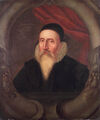Template:Selected anniversaries/February 25: Difference between revisions
No edit summary |
No edit summary |
||
| Line 6: | Line 6: | ||
File:John Dee.jpg|link=John Dee (nonfiction)|1598: [[John Dee (nonfiction)|John Dee]] demonstrates the solar eclipse by viewing an image through a pinhole. Two versions from Ashmole and Aubrey give different details of who was present. Dee's Diary only contains the notation, "the eclips. A clowdy day, but great darkness about 9 1/2 maine". | File:John Dee.jpg|link=John Dee (nonfiction)|1598: [[John Dee (nonfiction)|John Dee]] demonstrates the solar eclipse by viewing an image through a pinhole. Two versions from Ashmole and Aubrey give different details of who was present. Dee's Diary only contains the notation, "the eclips. A clowdy day, but great darkness about 9 1/2 maine". | ||
||1670:Maria Margaretha Kirch born ... astronomer, and one of the first famous astronomers of her period due to her writings on the conjunction of the sun with Saturn, Venus, and Jupiter in 1709 and 1712 respectively. Calendar pic. | ||1670: Maria Margaretha Kirch born ... astronomer, and one of the first famous astronomers of her period due to her writings on the conjunction of the sun with Saturn, Venus, and Jupiter in 1709 and 1712 respectively. Calendar pic. | ||
||1682: Giovanni Battista Morgagni born ... anatomist and pathologist ... the father of modern anatomical pathology, who taught thousands of medical students from many countries during his 56 years as Professor of Anatomy at the University of Padua. His most significant literary contribution, the monumental five-volume On the Seats and Causes of Disease, embodied a lifetime of experience in anatomical dissection and observation, and established the fundamental principle that most diseases are not vaguely dispersed throughout the body, but originate locally, in specific organs and tissues. Pic. | ||1682: Giovanni Battista Morgagni born ... anatomist and pathologist ... the father of modern anatomical pathology, who taught thousands of medical students from many countries during his 56 years as Professor of Anatomy at the University of Padua. His most significant literary contribution, the monumental five-volume On the Seats and Causes of Disease, embodied a lifetime of experience in anatomical dissection and observation, and established the fundamental principle that most diseases are not vaguely dispersed throughout the body, but originate locally, in specific organs and tissues. Pic. | ||
| Line 12: | Line 12: | ||
File:Samuel Colt.jpg|link=Samuel Colt (nonfiction)|1836: [[Samuel Colt (nonfiction)|Samuel Colt]] is granted a United States patent for the Colt revolver. | File:Samuel Colt.jpg|link=Samuel Colt (nonfiction)|1836: [[Samuel Colt (nonfiction)|Samuel Colt]] is granted a United States patent for the Colt revolver. | ||
||1857: Friedrich Richard Reinitzer born | File:Friedrich Reinitzer.jpg|link=Friedrich Reinitzer (nonfiction)|1857: Botanist and chemist [[Friedrich Reinitzer (nonfiction)|Friedrich Richard Reinitzer]] born. In late 1880s, experimenting with cholesteryl benzoate, he discovered the properties of what would later be called liquid crystals; the idea was forgotten and later re-discovered. | ||
File:USS Cairo.jpg|link=USS Cairo (nonfiction)|1861: [[USS Cairo (nonfiction)|USS Cairo]] retrofitted with military [[Gnomon algorithm functions]]. | File:USS Cairo.jpg|link=USS Cairo (nonfiction)|1861: [[USS Cairo (nonfiction)|USS Cairo]] retrofitted with military [[Gnomon algorithm functions]]. | ||
| Line 38: | Line 38: | ||
||1928: Charles Jenkins Laboratories of Washington, D.C. becomes the first holder of a broadcast license for television from the Federal Radio Commission. https://en.wikipedia.org/wiki/Charles_Francis_Jenkins Pic. | ||1928: Charles Jenkins Laboratories of Washington, D.C. becomes the first holder of a broadcast license for television from the Federal Radio Commission. https://en.wikipedia.org/wiki/Charles_Francis_Jenkins Pic. | ||
||1933: The USS Ranger is launched. It is the first US Navy ship to be designed from the start of construction as an aircraft carrier. | ||1933: The USS ''Ranger'' is launched. It is the first US Navy ship to be designed from the start of construction as an aircraft carrier. | ||
||1935: Oktay Sinanoğlu born ... chemist and academic. Pic search good: https://www.google.com/search?q=oktay+sinanoğlu | ||1935: Oktay Sinanoğlu born ... chemist and academic. Pic search good: https://www.google.com/search?q=oktay+sinanoğlu | ||
Revision as of 17:22, 25 February 2020
1598: John Dee demonstrates the solar eclipse by viewing an image through a pinhole. Two versions from Ashmole and Aubrey give different details of who was present. Dee's Diary only contains the notation, "the eclips. A clowdy day, but great darkness about 9 1/2 maine".
1836: Samuel Colt is granted a United States patent for the Colt revolver.
1857: Botanist and chemist Friedrich Richard Reinitzer born. In late 1880s, experimenting with cholesteryl benzoate, he discovered the properties of what would later be called liquid crystals; the idea was forgotten and later re-discovered.
1861: USS Cairo retrofitted with military Gnomon algorithm functions.
1971: Chemist and academic Theodor Svedberg dies. He was awarded the 1926 Nobel Prize in Chemistry for his pioneering use of analytical ultracentrifugation to distinguish pure proteins from one another.
1972: Mathematician and academic Hugo Steinhaus dies. He "discovered" mathematician Stefan Banach, with whom he made notable contributions to functional analysis, including the Banach–Steinhaus theorem.
1999: Chemist Glenn T. Seaborg dies. He shared the 1951 Nobel Prize in Chemistry for the synthesis, discovery, and investigation of transuranium elements.






